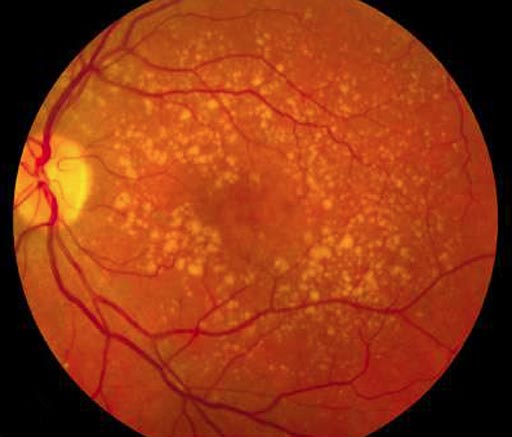Potential Biomarkers of AMD Identified in Human Plasma
By LabMedica International staff writers
Posted on 26 Sep 2017
Patients with even an early stage of age-related macular degeneration (AMD) carry signs of the disease in their blood that may be detected through special laboratory tests, according to a new study. The findings may lead to earlier diagnoses, better prognostic information, and ultimately more precise treatments for earlier stages of AMD, the leading cause of blindness in people over age 50 in developed countries.Posted on 26 Sep 2017
The study, led by researchers based at Massachusetts Eye and Ear Infirmary (Boston, MA, USA), a Harvard Medical School teaching hospital, found that applying metabolomics enabled identification of blood profiles associated with AMD and its level of severity.

Image: The back of the eye in a patient with age-related macular degeneration (AMD), showing multiple large drusen deposits and pigment changes (Photo courtesy of Massachusetts Eye and Ear Infirmary).
“Because the signs and symptoms of early stage AMD are very subtle, with visual symptoms only becoming apparent at more advanced stages of the disease, identification of biomarkers in human blood plasma may allow us to better understand the early to intermediate stages of AMD so we may intervene sooner and ultimately provide better care,” said co-senior author Joan W. Miller, MD, of Mass. Eye and Ear and of Massachusetts General Hospital, and professor at Harvard Medical School.
The prevalence of AMD is expected to increase along with aging of the global population. While AMD has recognized genetic and lifestyle risk factors (including diet and smoking status), the field currently lacks reliable measures to identify patients who may be at high risk of developing AMD, including those who may progress to the advanced, blinding forms of the disease.
“The metabolome – the set of metabolites present in an individual – is thought to closely represent the true functional state of complex diseases. This is why we used it to test 90 blood samples obtained from study participants with all three stages of AMD (30 with early-stage disease, 30 with intermediate-stage, 30 with late-stage) and 30 samples from patients without AMD,” said first author Ines Lains, MD, research fellow at Mass. Eye and Ear. The metabolomics data analysis was performed in collaboration with Dr. Lasky-Su and colleagues at the Channing Division of Network Medicine of Brigham and Women’s Hospital (Boston, MA, USA).
Their approach revealed 87 metabolites in the blood that were significantly different between subjects with AMD and those without. Furthermore, the team noted varying characteristics between the blood profiles of each stage of disease. Of the 87 molecules associated with AMD, most belonged to lipid pathways, and 6 of the 7 most significant metabolites identified were lipids. Previous research has suggested that lipids may be involved in the development of AMD, although the exact role of lipids in the disease process remains unclear. The results from this study support this suggestion, as well as indicate that metabolomics profiling may provide novel insights into relationship between lipids and AMD.
“We believe this work will help launch the era of personalized medicine in treatment of AMD,” said co-senior author Deeba Husain, MD, of Mass. Eye and Ear and associate professor at Harvard Medical School, “and it gives us clues to differentiate the progressers from non-progressors. This research also gives us insight into important role of lipids in AMD, which will provide novel targets for treatment in the early stage of disease, thus preserving vision."
The study, by Laíns I et al, was published September 12, 2017, in the journal Ophthalmology.
Related Links:
Massachusetts Eye and Ear Infirmary













